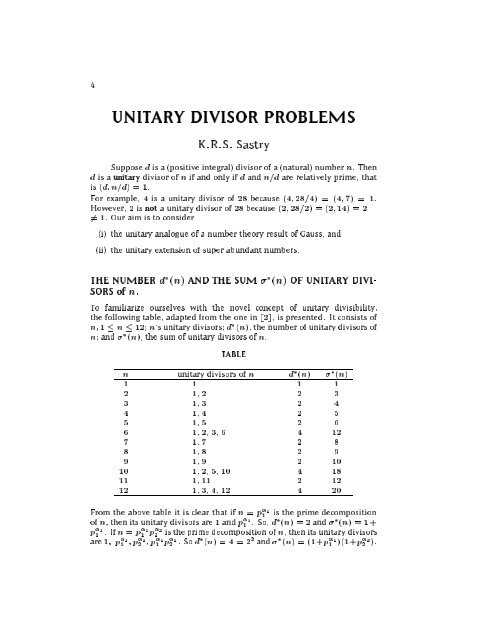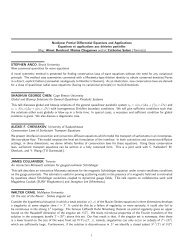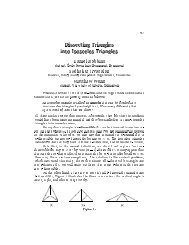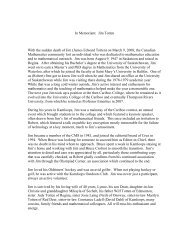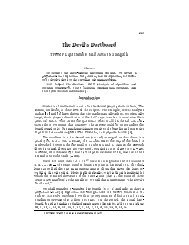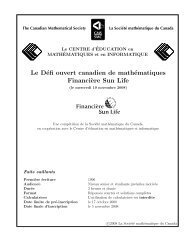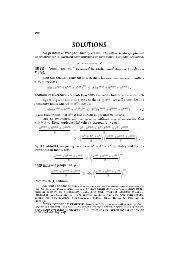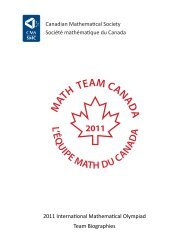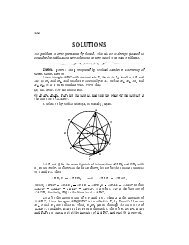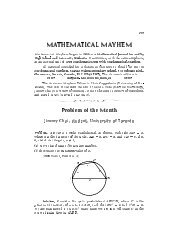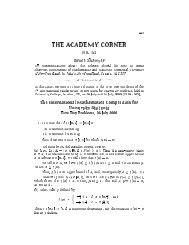UNITARY DIVISOR PROBLEMS
UNITARY DIVISOR PROBLEMS
UNITARY DIVISOR PROBLEMS
You also want an ePaper? Increase the reach of your titles
YUMPU automatically turns print PDFs into web optimized ePapers that Google loves.
4<br />
<strong>UNITARY</strong> <strong>DIVISOR</strong> <strong>PROBLEMS</strong><br />
K.R.S. Sastry<br />
Suppose d is a (positive integral) divisor of a (natural) number n. Then<br />
d is a unitary divisor of n if and only if d and n=d are relatively prime, that<br />
is (d; n=d) =1.<br />
For example, 4 is a unitary divisor of 28 because (4; 28=4) = (4;7) = 1.<br />
However, 2 is not a unitary divisor of 28 because (2; 28=2) = (2; 14) = 2<br />
6= 1. Our aim is to consider<br />
(i) the unitary analogue of a number theory result of Gauss, and<br />
(ii) the unitary extension of super abundant numbers.<br />
THE NUMBER d (n) AND THE SUM (n) OF <strong>UNITARY</strong> DIVI-<br />
SORS of n.<br />
To familiarize ourselves with the novel concept of unitary divisibility,<br />
the following table, adapted from the one in [2], is presented. It consists of<br />
n; 1 n 12; n's unitary divisors; d (n), the number of unitary divisorsof<br />
n; and (n), the sum of unitary divisors ofn.<br />
TABLE<br />
n unitary divisors ofn d (n) (n)<br />
1 1 1 1<br />
2 1,2 2 3<br />
3 1,3 2 4<br />
4 1,4 2 5<br />
5 1,5 2 6<br />
6 1,2,3,6 4 12<br />
7 1, 7 2 8<br />
8 1, 8 2 9<br />
9 1, 9 2 10<br />
10 1, 2, 5, 10 4 18<br />
11 1, 11 2 12<br />
12 1, 3, 4, 12 4 20<br />
From the above table it is clear that if n = p 1<br />
1 is the prime decomposition<br />
of n, then its unitary divisorsare1and p 1<br />
1 . So, d (n) =2and (n) =1+<br />
p 1<br />
1 .Ifn=p 1<br />
1 p 2<br />
2 is the prime decomposition of n, then its unitary divisors<br />
are 1; p 1<br />
1 ;p 2<br />
2 ;p 1<br />
1 p 2<br />
2 .Sod (n)=4=2 2and (n) = (1+p 1<br />
1<br />
)(1+p 2<br />
2 ).
Now it is a simple matter to establish the following results:<br />
Let n = p 1 2<br />
1 p2 p k<br />
k denote the prime decomposition of n.<br />
Then<br />
d (n) = 2 k ; (1)<br />
(n) = (1 + p 1<br />
1<br />
)(1 + p 2<br />
2<br />
5<br />
k<br />
) (1 + pk ); (2)<br />
If (m; n) = 1; then (mn) = (m) (n): (3)<br />
THE EULER FUNCTION AND A RESULT OFGAUSS.<br />
The Euler function counts the number (n) of positive integers that are less<br />
than and relatively prime to n. Also, (1) = 1 by de nition. For example,<br />
(6) = 2 because 1 and 5 are the only positive integers that are less than<br />
and relatively prime to 6. The following results are known [1]:<br />
If n = p 1<br />
1,1<br />
1 ; then (n) =(p1,1)p1 : (4)<br />
If n =<br />
kY<br />
i=1<br />
p i<br />
i ; then (n) =<br />
kY<br />
i=1<br />
(p i<br />
i ) : (5)<br />
If (m; n) =1; then (mn) = (m) (n): (6)<br />
Let D = fd : d is a divisor of ng. Then Gauss showed that P (d) =n.<br />
For example, if n =12, then D = f1; 2; 3; 4; 6; 12g and P (d) = (1) +<br />
(2)+ (3)+ (4)+ (6)+ (12) = 1+1+2+2+2+4 = 12. Analogously,<br />
if D = fd : d is a unitary divisor of ng, then what is P (d )? The answer<br />
is given by Theorem 1.<br />
Theorem 1 Let n =<br />
kY<br />
i=1<br />
p i<br />
i<br />
fd : d is a unitary divisor of ng. Then<br />
denote the prime decomposition of n and D =<br />
kY<br />
X<br />
(d )= [1 + (p<br />
i=1<br />
i<br />
i )] :<br />
Proof: The unitary divisorsofnare the 2 k elements, see (1), in the set<br />
D = f1; p 1<br />
1<br />
;p 2<br />
2<br />
; ;p k<br />
k<br />
;p 1<br />
1<br />
p 2<br />
2<br />
; ;p k,1<br />
k,1<br />
p k<br />
k<br />
; ;<br />
kY<br />
i=1<br />
p i<br />
i g:
6<br />
Hence<br />
X (d )= (1) +<br />
kX<br />
i=1<br />
(p i<br />
i )+<br />
X<br />
i 2(150).<br />
To extend the work of Erdos and Alaoglu [3], we call a natural number<br />
(n) (m)<br />
n unitary super abundant if n m<br />
Theorem 2 shows that the product of the<br />
unitary super abundant number.<br />
for all natural numbers m<br />
rst k primes, k = 1;2;<br />
n.<br />
is a<br />
kY
Theorem 2 Let pk denote the k th prime, k =1;2; :Then n = p1;p2 pk<br />
is a unitary super abundant number.<br />
Proof: Consider the natural numbers ofm n. Then m belongs to one of<br />
the three groups described below.<br />
I. m is composed of powers of primes pj<br />
pk.<br />
II. m is composed of powers of some primes pj<br />
primes p` >pk.<br />
III. m is composed of powers of primes p`<br />
pk.<br />
7<br />
pk and powers of some<br />
First of all we note that the total number of primes composing m in any of<br />
the three groups does not exceed k.<br />
We now show that<br />
(m)<br />
m<br />
Case I. Let m = p 1<br />
1<br />
zero. From (2) we see that<br />
p 2<br />
2<br />
(m)<br />
m<br />
(n)<br />
n<br />
=<br />
=<br />
=<br />
in all the above three cases.<br />
p j<br />
j where some 's, except j, may be<br />
jY<br />
i=1<br />
i6=0<br />
jY<br />
i=1<br />
i6=0<br />
jY<br />
i=1<br />
i6=0<br />
kY<br />
i=1<br />
(n)<br />
n<br />
1+p i<br />
i<br />
p i<br />
i<br />
1+ 1<br />
p i<br />
i<br />
1+ 1<br />
1+ 1<br />
pi<br />
pi<br />
: (7)<br />
Case II. In this case m = p 1<br />
1 p 2<br />
2 p j k+1<br />
j pk+1 p `<br />
` :Here too (7)<br />
holds. Some 's, except j and `, may be zero. Furthermore,<br />
`>k)1+ 1<br />
p`<br />
8<br />
Again, from (2) and (3)<br />
(m)<br />
m<br />
on using (7) and (8).<br />
=<br />
=<br />
=<br />
jY<br />
i=1<br />
i6=0<br />
jY<br />
i=1<br />
i6=0<br />
kY<br />
i=1<br />
kY<br />
i=1<br />
(n)<br />
n ;<br />
1+p i<br />
i<br />
p i<br />
i<br />
1+ 1<br />
p i<br />
i<br />
1+ 1<br />
p i<br />
i<br />
1+ 1<br />
pi<br />
`,k Y<br />
i=1<br />
i6=0<br />
`,k<br />
Y<br />
i=1<br />
i6=0<br />
k+i<br />
1+pk+i p k+i<br />
!<br />
k+i<br />
1+<br />
1<br />
p k+i<br />
k+i<br />
Case III. In this case m = p k<br />
k p `<br />
` . Here too (7) holds. Some 's,<br />
except `, may be zero. As in earlier cases<br />
(m)<br />
m<br />
=<br />
=<br />
`,k Y<br />
i=0<br />
i6=0<br />
`,k<br />
Y<br />
i=0<br />
kY<br />
i=1<br />
(n)<br />
n<br />
1+<br />
1<br />
p k+i<br />
k+i<br />
1+ 1<br />
pk+i<br />
1+ 1<br />
pi<br />
!<br />
on using (8).<br />
We now give anexample of a number n to show that there arevalues<br />
of m less than n that can belong to any of the three groups described in<br />
Theorem 2.<br />
Let n =210=2:3:5:7. Then<br />
(n)<br />
n<br />
96<br />
=<br />
35 .<br />
I. m =120=2 3 :3:5is less than n and belongs to Group I.<br />
Here<br />
(m)<br />
m<br />
= 9<br />
5<br />
(n)<br />
holds.<br />
n<br />
II. m =165=3:5:11 is less than n and belongs to Group II.<br />
Here<br />
(m)<br />
m<br />
= 96<br />
55<br />
(n)<br />
holds.<br />
n<br />
!
III. m =143=11:13 is less than n and belongs to Group III.<br />
Here too,<br />
(m)<br />
m<br />
= 168<br />
143<br />
(n)<br />
holds.<br />
n<br />
If we write nk = p1p2 pk;k =1;2; , then we observe that<br />
(nk+1)<br />
nk+1<br />
=<br />
><br />
(nk)<br />
nk<br />
(nk)<br />
nk<br />
1+ 1<br />
pk+1<br />
; k =1;2; :<br />
This above observation, coupled with the argument used in the proof of Theorem<br />
2, implies Theorem 3.<br />
Theorem 3 The only unitary super abundant numbers are<br />
That is<br />
Acknowledgement.<br />
nk; k=1;2;3; :<br />
2; 6; 30; 210; 2310; :<br />
The author thanks the referees for their suggestions.<br />
References<br />
[1] L.E. Dickson, History of the Theory of Numbers, Vol. I, Chelsea Publications<br />
(1971), 113{114.<br />
[2] R.T. Hanson and L.G. Swanson, Unitary Divisors, Mathematics Magazine,<br />
52 (September 1979), 217{222.<br />
[3] R. Honsberg, Mathematical Gems I, MAA, 112{113.<br />
9<br />
2943 Yelepet<br />
Dodballapur 561203<br />
Bangalore District<br />
Karnataka, India


